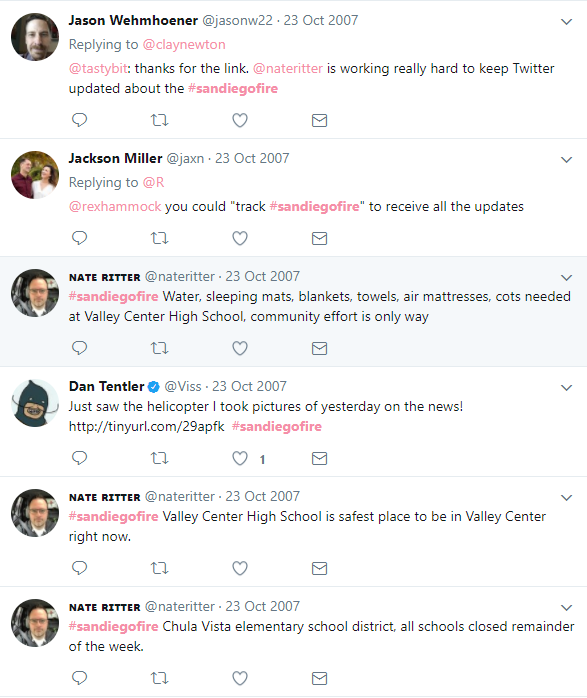n our previous article (What is a hashtag?) we explained what hashtags are.
Today, let’s delve deeper into the subject of hashtags and learn more about the history of a sign that has left an impact on our society in a way not many other signs in recent history have.
Hashtags are all around us these days and it is somewhat difficult to imagine the world in which we are not seeing them absolutely everywhere. It might sound strange but it’s true — as recently as 2007, we called them “pound signs”, “hash symbols” or an “Octothorpe”, and unless you were working in IT, you weren’t really thinking much of them.
Today? It is not likely you can go through your day without running into a couple of hashtags at the very least. But let’s start from the beginning.
Our story starts with an Octothorpe
Before we started calling it a “hashtag”, we called it the “number sign”, or the “pound sign”. Before that? It was known as an Octothorpe.
The etymological origin of the name is disputed and will likely never be clear, but what we do know is that in the late 1960’s to early 1970’s, the innovators of the Touch-tone telephone, Bell Laboratories, sent out their researchers to interview the public and find out which signs the American people would prefer using in the new technologies they were developing at the time.
The results of this market research helped the researchers at Bell Laboratories narrow their choices down to an asterisk (*) and a number sign (#).
The Mayo Clinic in USA was one of the first locations fully equipped with the new Touch-tone technology, and it is said that, when it came time to train the Mayo Clinic staff on how to use the new technology, Bell’s Don McPherson coined the term “Octothorpe”.
Allegedly, he had come up with the name by combining the word “octo”, because of the eight points of the number sign, with the name of his favorite athlete – Olympian Jim Thorpe.
There is no evidence to support this claim, however, so it might just be a colorful yet fabricated story. Still, it is an interesting one nonetheless!
Hashtags in programming
Between 1969 and 1973, Dennis Ritchie collaborated with the same Bell Laboratories on developing a programming language that would support structured programming, lexical variable scope, and recursion — while a static type system would prevent many unintended operations.
When finished, the language was named C and is to date one of the most widely used programming languages of all time. Within the C preprocessor (CPP), the Octothorpe was used to define various directives — such as constants, macros, and special commands to the compiler.
“#” jumps to IRC
In 1993, the pound symbol found its use in Internet Relay Chat (IRC) channels as a command that would allow users to join various channels, as well as label groups of topics, images, and messages.
Channels which were prefixed with a “#” were available across an entire IRC network, while those local to a server were prefixed with a “&”.
/join #Twitter
The Octothorpe was by now very well established among the tech folk and it is said that its use in IRC channels was exactly what, on August 23rd, 2007, inspired Chris Messina to suggest his followers start using it as a way to categorize groups on Twitter.
As a popular and steadily growing microblogging platform, Twitter had an estimated 340 000 users back then, with 2000 new users joining daily.
Two days after this iconic tweet another – perhaps equally important – was tweeted by Stowe Boyd.
It was on August 25th, 2007 that the “pound” sign became known as a “hash tag” — and eventually, simply a “hashtag”.
It is interesting to see how quickly the term was embraced by the public — and how quickly we opted to use “hashtag” over “hash tag”.
Let’s continue! A couple of months later, in October of 2007, the Twitter community recognized the value of hashtags as Chris Messina has envisioned them being used on Twitter when the San Diego forest fires created a need for emergency coordination and disaster relief.
The #SanDiegoFire hashtag became one of the important tools the people of Twitter used to communicate with each other and share the updates on the developing situation in San Diego.

Despite the community recognizing the value of hashtags early on and embracing them wholeheartedly, it took Twitter until July 2nd, 2009, to begin hyperlinking all hashtags in tweets to Twitter search results.
In 2010, Twitter also launched a feature that helped the website become what it is today. Trending topics were introduced on the front page, constantly displaying hashtags which are becoming rapidly popular at any given hour.
Other social media sites embrace the hashtag
With more or less haste, other social media sites have decided to embrace hashtags, each in their own way and tailoring them to the specific needs of their users.
Already on August 18th, 2009 — just a couple of months after Twitter has started hyperlinking hashtags to Twitter search results — Tumblr was the first of large social media sites to start using hashtags. Tumblr promoted them as “Tumblr’s Tag Channels”, helping their users filter through tagged posts in real time.
Two years later, on January 26, 2011, Instagram also introduced hashtags to its platform, allowing the users to tag their own photos by adding a hashtag in the caption of the photo or in a comment. Additionally, Instagram made it so that each hashtag had its own RSS Feed associated with it, which made it incredibly easy to subscribe to new photos.
On October 12, 2011, Google+ introduced real-time search and hashtag support across the entire social network.
Facebook decided to introduce hashtags on its platform on June 12, 2013, as a way to encourage conversation and help people discuss current events in real-time, or simply to help its users add context to their posts.
Finally, on June 13, 2016, YouTube joined the other social media giants in embracing the power of hashtags as it integrated them into the platform by making them searchable across the site whether they are used in the video title or the video description box.
Hashtags today
We don’t only use them on social media sites to categorize our thoughts and interactions anymore. Today they are used on blogs and news sites, in the media and even in fashion!
Hashtags have long ago stopped being “an IT thing” and are today more important than ever. Whether you use them to connect with a niche you belong to or as a marketing tool, you are likely using hashtags in your day-to-day life already.
You might be promoting events or raising brand awareness. Or maybe you are just enjoying your favorite TV show while tweeting your thoughts and reactions to what you’re seeing. Either way, hashtags have made connecting with people easier than ever.
Where will hashtags go from here? One thing is for certain — their impact isn’t going to shrink any time soon.
So now that you know all about the history of hashtags, what do you think of their future? Tweet us your thoughts at @WalleryAppHQ, we’d love to hear what you think!






